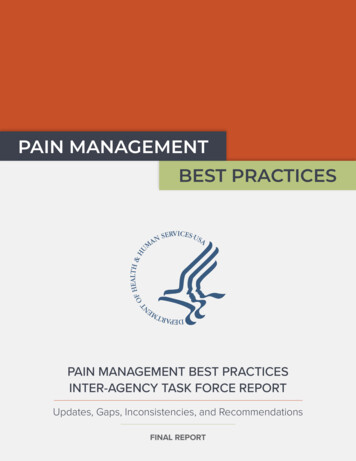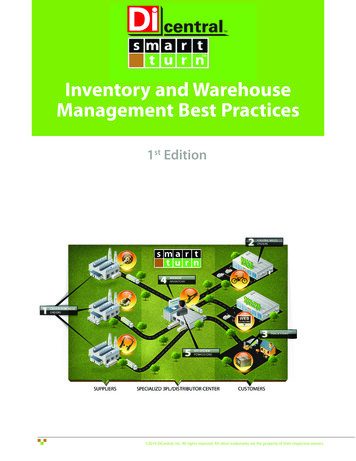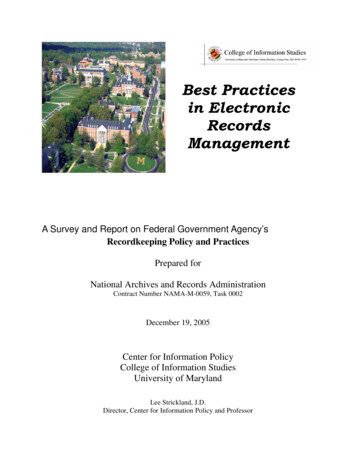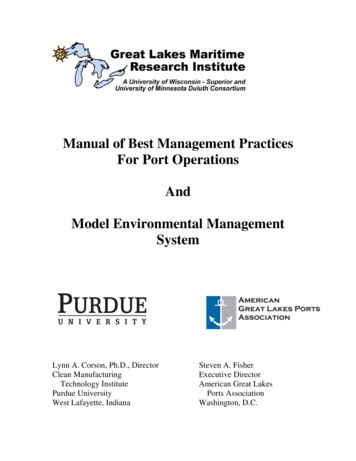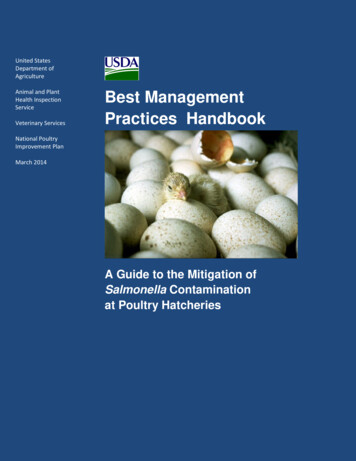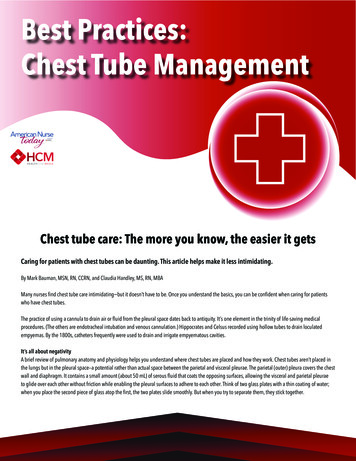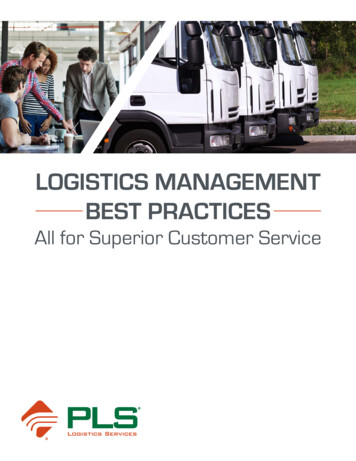
Transcription
LOGISTICS MANAGEMENTBEST PRACTICESAll for Superior Customer Service
Logistics management plays a significant role in the successof any company’s operations and has a direct impact on itsbottom line. More importantly, logistics processes play a bigpart in customer satisfaction, which is more important thanlow product costs. Logistics professionals should think ofthemselves as a customer-facing portion of the companyand strive every day to add value for their customers.The Council of Supply Chain Management defines logisticsmanagement as:“ that part of supply chain management that plans,implements and controls the efficient, effective forward andreverse flow and storage of goods, services and relatedinformation between the point of origin and the point ofconsumption in order to meet customers’ requirements.”Logistics management is often confused with supply chainmanagement. Supply chain management has broaderobjectives and actually encompasses logistics management.Supply chain management (SCM) includes inter-enterprise,multi-functional processes that target everything from thesupplier’s inbound freight to the end consumer. Logisticsmanagement (LM) is the more practical, hands-on part ofthe supply chain where goods are transported into a facility,properly stored, handled and transported out. LM focuseson short-term procedures and SCM is focused on thelong-term.In this whitepaper, you will learn about the development andfocal points of logistics management, difficulties companieshave within these focal points and the best practices toachieve optimized logistics, which leads to superiorcustomer service.LOGISTICS STRATEGY40%can be savedon logistics costsby making quick,informed decisionsMaking quick, informed decisions can save a company upto 40% on logistics costs, so one of the best practices inLM is to implement a fine-tuned logistics strategy. Sincethe supply chain is constantly changing, so are logisticsprocesses. Developing and implementing a formal logisticsstrategy will add flexibility to the decision making processand increase error-response time. A deliberate strategy willlet a company predict service disruptions and know how andwhen to respond to them to ensure service levels stay atpeak performance.How does a company implement a logistics managementstrategy? First, assess all logistics functions. Take a look atevery part of the organization’s logistics management anddefine how it should work and how it contributes to overallsupply chain management goals. Look at each physical partof the logistics process and determine its optimum function;2
i.e. are distribution centers in the right locations and arethere enough of them?Even after a strategy is applied, continue to evaluate itssuccess and ask if there are other opportunities. The entiresupply chain environment is continually evolving, so logisticsroles must be flexible. To design a new strategy or analyzeyour existing logistics processes, ask and answer these 8questions: A LOGISTICS STRATEGYmust be evaluated regularly tofind new opportunitiesINBOUND LOGISTICSDo you have a way to handle expedited shippingdifferently than slower moving shipments? Would it bebeneficial to do so?Is there a plan that defines when an item should beinventoried and when an item should be sent directly toa customer?Would it be more effective to have a third partylogistics (3PL) company manage some or all aspectsof your logistics functions? What financial and serviceconsiderations must you take into account before makingthis decision?Can your distribution network be improved?Could a change of carrier or mode save money orimprove service in outbound transportation?Do you carry too much inventory? Too little?What are your specific customer service goals? Is it easyitem returns? Delivery speed? Safety?What future business operations will affect logisticsfunctions and are you prepared to handle them?For every business, there are different logistics needs anddifferent ways to evaluate operational success. A staticlogistics strategy will cause serious harm to customerservice and the bottom line. It’s detrimental to notbenchmark success or direction for improvement. While thelogistics environment changes frequently, and the amountof data available for analysis grows, you have to activelystrategize in order to stay ahead of the fluctuations toavoid disorder. The only way to do this is to ask questionsabout your logistics processes, evaluate successes andinefficiencies, and alter your logistics management strategyto fit your company’s changing needs.Inbound logistics is one of the most overlooked aspectsin logistics management. On average, companies canpotentially save between 20 – 58% on inbound freightspend. Most companies focus on outbound logistics asthis is a low-hanging fruit. There are usually more pressingmatters for a business to attend to, and many lack anycontrol over inbound freight. However, to drive significant3
savings and improve customer service, it is critical to gaincontrol of inbound logistics.FREIGHT PAID TO FREIGHT COLLECT20-58%can be saved on inboundfreight spendThis is a simple change most companies can effortlesslyimplement. Freight Paid is a common payment methodfor inbound freight among shippers. Freight Paid meansthat the supplier pays for transportation costs. A switch toFreight Collect is advantageous; this is where the consigneepays for freight cost. It might sound counterintuitive,but it’s important to keep in mind that the company whoimmediately pays a carrier is not necessarily the partyultimately responsible for the cost of transportation.Switching to Freight Collect will give your company controlover inbound logistics. Often, the true cost of transportationis hidden in the price of a product, between 4 and 7% of thetotal cost. With control over inbound freight, you know exacttransportation costs and can streamline the truck’s route byhaving it drive straight to your distribution center, not makingan extra stop at the supplier’s distribution center.Freight Collect is a best practice in logistics managementbecause this method will give you visibility into the inboundprocess. Visibility makes identifying inefficiencies andimplementing change possible. With visibility, a companycan analyze carrier performance, track overall costs, predictand avoid disruptions, and analyze vendor performance.Then, choose the best combination to save money andtime; these benefits will be seen by your customer throughimproved service.VENDOR COMPLIANCE PROGRAMSA lot of companies don’t pay attention to inbound freight,and even fewer see the necessity of a vendor complianceprogram (VCP). These companies are missing out onpotential profits, streamlined logistics functions andimproved customer service, among many other benefits. Agood VCP can be a competitive differentiator.A proper VCP will define expectations and benchmarks forthe vendor, have a way of tracking and reporting vendorperformance, include frequent meetings to discuss anynecessary changes, and ensure all consignee goals areconsistently met.3 reasons to have a vendor compliance program: Current Logistics Environment: Logistics processes aremore and more complicated every year. This means thatthere are more opportunities for errors than ever before,and in today’s world, errors disrupt the supply chain.Every point of the logistics process is dependent on each4
TODAY’S SOFTWAREother, and the entire logistics process is just one point ofthe overall supply chain. Any inefficiencies or minor slipup in inbound freight management affects the internalprocess, the customer, and even the end-consumer. Technology: Technology became very important intransportation and logistics after the recession, whentransportation departments downsized. Since then,the available technology has grown and improvedsignificantly. Today’s software can measure and analyzejust about anything, giving you a good chance of successat any logistics venture. If you’re not taking advantageof available technology to set up a controlled andmonitored VCP, then you will fall behind those who douse transportation management software to their benefit. Efficiency: Logistics management is customer-facing,and as such, its efficiency reflects the whole company.Customers are demanding more which stresses thelogistics process. Maintaining high efficiency is theonly way to ensure customer demands are met withoutsignificantly increased costs. Inbound freight needs to runas smoothly as possible for the best customer experience.can measure and analyze justabout anything, giving you agood chance of success at anylogistics ventureAs you can see, a proper VCP is necessary to havecompetitive logistics management processes. To ensurea VCP is successful, work with the vendor at every step.Rather than fighting over requirements, or simply charginga vendor for bad service, collaborate to solve problems andimprove service. Today, programs take a strategic approach,focusing on flow and efficiency, using advanced cloud-basedsoftware to predict compliance issues before they occur.Simply put, don’t just tell a supplier when they do somethingwrong, establish a mutually beneficial relationship; helpthem achieve success and reward them for being reliable.Reliability is invaluable in this volatile industry and economy.When a VCP is successful, and two companies have a greatworking relationship, companies will see reduced inventoryand safety stock, improved warehouse operating costs,overall reduced inbound costs (with value-added), andenhanced customer service. Fully investing in a VCP maybe taxing at first, but, when successful, it is worth the effort.REVERSE LOGISTICSA well-planned, customized reverse logistics strategywill reduce storage and distribution costs, improve brandreputation, create more sustainable business practices, andsatisfy customer demands.Reverse logistics is a type of inbound freight that mostcompanies are losing money on. It’s seen as an expensive,complex challenge and many companies avoid managing it.5
8.1%of total sales is the averageretailer’s reverse logistics costs forconsumer goodsIt requires an efficient, sustainable approach to resolve eachindividual item-level issue. It also requires full support fromsenior management, which is rarely provided. However,reverse logistics is vital to the customer experience and it isimportant that it’s managed properly.A good reverse logistics program generates maximum valuefrom each item returned. Returns impact the bottom line.An average retailer’s reverse logistics costs for consumergoods are equal to 8.1% of total sales. In some industries,such as book publishing, catalog retailing and greetingcards, over 20% of all products sold are eventually returnedto the vendor.Quality and distance traveled determine the backward pathof the product and its final form and destination. The longera product stays in the system, the less valuable it becomes.And, of course, already damaged goods and packages willget worse being transported again. A time-sensitive categoryof products, like those with technology components, losemarket value with each passing week. It’s best practice tominimize the time items spend within the system to ensuremaximum reclaimed value.69%of customers think of greatcustomer service as quickresolution of problemsReverse logistics is important for customer service. 69%of customers think of great customer service as quickresolution of problems. For example, consumers whoorder clothes online typically order several different sizesand colors of the same item. Then, they’ll send back theproducts that don’t fit or aren’t the right color. If this processis difficult, they won’t order from you again. Good reverselogistics practices, and by extension customer service,include a return shipping label and easy packaging forreturns. This encourages future purchases.Not to mention, reverse logistics can reduce environmentalwaste (and improve your company’s waste costs). More andmore customers appreciate companies who take social andenvironmental responsibilities seriously, so implementing greenpractices can further improve the customer’s experience.TRANSPORTATIONMANAGEMENT SYSTEMS(TMS)TMS technology is absolutely necessary for any logisticsoperation. This software will measure and report detailedshipping records for inbound and outbound freight, monitorvendor and carrier performance, optimize routing and modechoice, and most importantly, help give you end-to-end visibilityof freight movement. Not to mention, a TMS can reduceoverall transportation costs by 30%. If implemented and usedproperly, a TMS is invaluable to your logistics objectives.6
USE THE RIGHT TMS FOR YOUR NEEDS30%reduction intransportationcosts by usinga TMSWhen purchasing a TMS, or evaluating the success of yourcurrent system, the first thing to consider is what your specificneeds are. Consider how it will be used, what benefits itshould provide and how well it will grow with the company.There are many options to choose from, and choosing thewrong TMS software will lead to unnecessary costs andlimited value gained from the data-generating system.To get full value from a TMS system, there are 6must-have features: Carrier Contract Management: Dealing with multiplecarrier relationships at once, all with different contracts,is challenging. A TMS will alert you when a contract isup, display total shipping costs, help establish pricing,and track terms and agreements in real-time. You willalways be sure you and your carriers are following theterms of your contract, as well as any special locationbased regulations. Parcel Shipping Support: In recent years, demandforecasting has become more and more accurate. Thistriggered lower inventories, with many businesses usinga ‘Just in Time’ approach where items are received onlyas needed. In general, there is demand for smaller, morefrequent shipments. In turn, this has caused a universalneed for parcel shipping. Item
Supply chain management (SCM) includes inter-enterprise, multi-functional processes that target everything from the supplier’s inbound freight to the end consumer.




